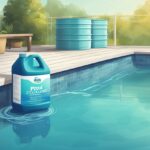Maintaining balanced water chemistry is crucial for the health of your spa pool and the comfort of its users. One key component of this balance is the pool’s alkalinity level, which acts as a buffer for pH stability. High alkalinity can cause cloudy water, scale formation, and can interfere with the effectiveness of sanitizers. If your spa pool’s total alkalinity readings exceed the recommended range of 100-150 mg/L, it’s time to take steps to bring it back into balance.

Lowering the alkalinity in your spa pool involves the careful addition of certain chemicals. Sodium bisulphate or muriatic acid are commonly used for this process. Both these chemicals require safe handling and accurate measurement to ensure they effectively reduce the alkalinity without causing harm to the pool’s surfaces or equipment. It’s important to follow proper procedures, such as turning off the pool pump and allowing the water to become still before the addition of chemicals, to achieve the desired results.
When using muriatic acid, you’ll want to pour the required amount into the deepest part of the pool, aiming to avoid pool walls or metal fittings to prevent damage. Conversely, when opting for sodium bisulphate, mixing it in a bucket of pool water before evenly dispersing it around the perimeter of your spa pool is usually the recommended method. By following these guidelines, you’ll ensure your pool’s alkalinity is controlled without adversely affecting the pH balance, ensuring a safe and enjoyable environment for all spa pool users.
Understanding Alkalinity in Spa Pools
Alkalinity, a key component of water chemistry, acts as a buffer to stabilise pH levels in your spa pool. Total alkalinity measures the concentration of alkaline substances in the water, primarily bicarbonates, carbonates, and hydroxides. It’s crucial because it influences the water’s ability to neutralise acids, thereby maintaining a stable pH.
- Ideal Range: Your spa pool’s alkalinity should typically be between 80 and 120 parts per million (ppm).
- Testing Alkalinity: You can test your spa’s alkalinity using testing strips or a kit, often available from your local supplier.
If your spa pool has high alkalinity, you may encounter issues such as cloudy water and scale formation, which can damage pool surfaces and equipment. Conversely, low alkalinity can cause pH to fluctuate erratically, leading to corrosive water that can harm both the spa and its users.
Common causes for alkalinity fluctuation include:
- New water from a water source with a different alkalinity level
- Heavy usage
- Rainwater or debris altering water chemistry
Maintaining water balance is essential. Balanced spa water should be neither too alkaline nor too acidic. Regular testing of your spa’s water chemistry ensures ideal conditions for your relaxation and the longevity of your spa. Remember, maintaining proper alkalinity levels not only ensures comfortable and clear water but also protects the components of your spa pool from corrosion and scaling.
Testing and Adjusting Alkalinity
Before attempting to adjust the alkalinity in your spa pool, it’s essential to conduct an accurate test. You can utilise a reliable testing kit, which typically includes test strips or a liquid testing solution, to measure both the pH level and total alkalinity.
- Testing Alkalinity:
- Dip a test strip into your spa water, ensuring it’s fully submerged.
- Compare the colour change to the chart provided with your kit.
- For liquid tests, follow the kit’s instructions closely to add the correct number of drops.
The optimal range for total alkalinity is usually between 80 and 120 parts per million (ppm). Once you’ve ascertained your pool’s alkalinity, you can proceed to adjust it if needed.
-
Lowering Alkalinity:
If your total alkalinity is above the recommended range, you may add a pH decreaser like dry acid (sodium bisulfate) or muriatic acid. Here’s how to safely apply these chemicals:Chemical Usage Muriatic Acid Dilute with water before adding to the pool. Target the deepest area. Dry Acid (Sodium Bisulfate) Sprinkle the granules evenly over the water’s surface. -
Begin with a smaller dosage and circulate the water using your pool pump.
-
Recheck the alkalinity after 5 hours and adjust as necessary.
Adjusting pH Levels:
- Post alkalinity adjustment, test pH levels.
- Should pH levels drop too low, incrementally add soda ash to raise it.
Throughout the process, exercise patience and proceed cautiously, keeping in mind that it’s easier to make gradual adjustments than correct overcorrections. Always refer to manufacturer guidelines for specific dosages based on your pool’s volume.
Chemical Treatments and Dosage
When addressing high alkalinity in your spa pool, using chemical treatments effectively is crucial. Your primary options include acids, which serve to lower pH and alkalinity, and other specialty chemicals designed for spa water balance.
Muriatic Acid (Hydrochloric Acid):
Muriatic acid is a powerful option for lowering both pH and alkalinity. It’s important to:
- Add it slowly, ideally in a well-ventilated area to avoid inhaling fumes
- Handle with care, wearing gloves and eye protection
- Dilute with water before application, following the manufacturer’s recommendations
Dry Acid (Sodium Bisulfate):
Sodium bisulfate, or dry acid, offers a safer alternative to muriatic acid. It is typically sold as pH decreaser or pH reducer. To use:
- Pre-dissolve in water as per product instructions
- Add to the spa pool while the circulation pump is running
Dosage:
Refer to the specific product guidelines for dosage, as it will vary based on:
- The current alkalinity level
- The volume of your spa pool
Here’s a simplified dosage guideline:
| Chemical | Dosage (Approximate) |
|---|---|
| Muriatic Acid | 100 mL per 1,000 L |
| Dry Acid | 100 g per 1,000 L |
Adjust based on your initial alkalinity readings, and retest after treatment.
Interactions with Chlorine:
High alkalinity can reduce chlorine effectiveness, leading to sanitisation issues. Once alkalinity is adjusted, chlorine will be more efficient in maintaining clean and safe spa water.
Avoiding Alkalinity Increase:
Prevent the spike in alkalinity by limiting the use of bicarbonates and carbonates, which are found in some alkalinity increasers. Remember, every addition of chemicals will interact with your spa’s delicate balance. Treatments should be incremental, always retesting the water before adding more chemicals.
Maintenance and Prevention Strategies

Maintaining the right alkalinity in your spa pool is crucial for ensuring water balance and longevity of pool equipment. Alkalinity, measured in parts per million (ppm), acts as a pH buffer to stabilise your spa water. The ideal alkalinity range for a spa pool is between 80 and 120 ppm.
Regular Testing: You should frequently test your spa’s pH and alkalinity levels to prevent wide fluctuations that can lead to skin and eye irritation. Use test strips or a liquid test kit to monitor the water chemistry regularly.
- Adjusting Alkalinity: If alkalinity is high, gradually add an acid—like muriatic acid or sodium bisulfate—to lower it. Ensure your pump is running to distribute the acid evenly.
- Acid Additions: Add the acid directly to the water near the return jets, then wait for it to circulate. Test the water after an hour and repeat if necessary, but avoid adding large quantities of acid all at once.
Water Circulation: Proper aeration helps raise pH levels while leaving alkalinity unchanged. This can be useful if your adjustments lead to a low pH.
- Pump Operation: Run your pump daily to maintain uniform water chemistry and prevent scale buildup on spa equipment.
Balancing Chemicals: Incorporate a routine of sanitising with chlorine or bromine to curb bacteria growth, which can cause chemical imbalances.
Refilling Strategy: Over time, diluting old spa water with fresh water can naturally decrease high alkalinity levels. Consider partial refills as a simple yet effective way to maintain water balance.
Calcium Hardness Control: Regularly check calcium hardness as high levels can lead to scale, which affects pH and alkalinity. Adjusting hardness levels can prevent corrosion and protect your spa equipment.
Safety Measures: Always wear goggles when handling chemicals to safeguard your eyes against splashes.
By implementing these strategies, you keep your spa’s alkalinity in check, preventing damage to the pool and plumbing while ensuring the water is comfortable for users.











